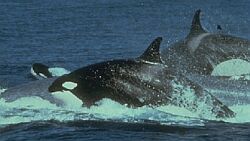|
EUROPEAN CETACEAN BYCATCH CAMPAIGN |
|
It's possible that killer whales tested several decades ago might have registered a higher level, Ross said. But making such a comparison is problematic because contaminant-analysis methods have changed, he said. |
|
One curious aspect of the Dungeness Spit orca is that, unlike |
|
most marine mammals that die and are tested for contamination, |
|
its body showed signs of a healthy diet. Most marine mammals |
|
that are found dead appear emaciated. |
|
That indicates those animals had been burning blubber to stay alive |
|
.When they do this, most of the contaminants remain behind, |
|
meaning that by the time they die there is a higher proportion of |
|
contaminants to the fat remaining. The Dungeness Spit orca, |
|
though, was fat. It had recently eaten three harbor seals. |
|
And yet it still had a very high PCB level. |
|
Norberg, the fisheries service marine mammal coordinator, |
|
said the high PCB level found in the orca might not be indicative |
|
of body burdens of transient orcas in general. "You're dealing with |
|
an orca that is dead on the beach, and a lot of folks argue that that's |
|
not representative of those that are out swimming around," |
|
Norberg said. |
|
Orca advocate Fred Felleman, who attended the seminar last week |
|
where the PCB readings were discussed, said efforts should be |
|
redoubled to find out where the PCBs came from. |
|
"The fact that killer whales could achieve those levels eating |
|
exclusively in the ocean is a red alert that we need to take better care |
|
of the ocean," Felleman said. |
|
|

